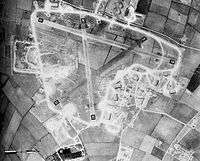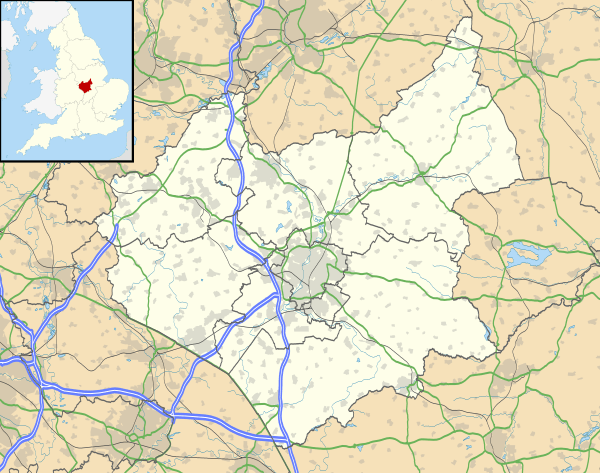RAF Bottesford
Royal Air Force Bottesford or more simply RAF Bottesford is a former Royal Air Force station located on the Leicestershire-Lincolnshire county border, 6.8 miles (10.9 km) north west of Grantham, Lincolnshire and 7.6 miles (12.2 km) south of Newark-on-Trent, Nottinghamshire and about 107 miles (172 km) north-northwest of London, England.
RAF Bottesford USAAF Station AAF-481  | |||||||||||||||||||
|---|---|---|---|---|---|---|---|---|---|---|---|---|---|---|---|---|---|---|---|
 RAF Bottesford, April 1944. Today, most of the airfield remains intact. | |||||||||||||||||||
| Summary | |||||||||||||||||||
| Airport type | Royal Air Force station | ||||||||||||||||||
| Owner | Air Ministry | ||||||||||||||||||
| Operator | Royal Air Force United States Army Air Forces | ||||||||||||||||||
| Location | Bottesford, Leicestershire | ||||||||||||||||||
| Built | 1940 | ||||||||||||||||||
| In use | 1941-1948 | ||||||||||||||||||
| Elevation AMSL | 108 ft / 33 m | ||||||||||||||||||
| Coordinates | 52°57′50″N 000°46′54″W | ||||||||||||||||||
| Map | |||||||||||||||||||
 RAF Bottesford Location in Leicestershire | |||||||||||||||||||
| Runways | |||||||||||||||||||
| |||||||||||||||||||
Opened in 1942, it was used by both the Royal Air Force (RAF) and United States Army Air Forces (USAAF). During the war it was used primarily as a troop carrier airfield for paratroopers and as a bomber airfield before closing in 1948.
Today the remains of the airfield are located on private property with the technical site being used as an industrial estate.
History
RAF Bomber Command use
The airfield was opened as a RAF Bomber Command station in No. 5 Group RAF area during the autumn of 1941, with No. 207 Squadron RAF moving in with its troublesome Avro Manchesters during November. However, because of continual difficulties experienced with their Rolls-Royce Vulture engines operations were frequently curtailed, but in March 1942 the squadron was able to step up its bombing raids on Germany when it became one of the first to receive the new Avro Lancaster in March 1942.
No. 207 Sqnn left in September 1942 for RAF Langar and in November a new Australian manned squadron, No. 467 Squadron RAAF, arrived in November 1942 commencing operations on the night of 2/3 January 1943.
USAAF use
It was first occupied by the 50th Troop Carrier Wing Headquarters on 15 November. It was then opened as a reception base for Douglas C-47/C-53 Skytrain groups that were scheduled to fly in from the United States.
It was known as USAAF Station AAF-481 for security reasons by the USAAF during the war, and by which it was referred to instead of location. It's USAAF Station Code was "AQ".
436th Troop Carrier Group
The first USAAF group to arrive at Bottesford was 436th Troop Carrier Group a few days into the New Year from Baer Army Airfield, Indiana. Operational squadrons of the group were:
- 79th Troop Carrier Squadron (S6)
- 80th Troop Carrier Squadron (7D)
- 81st Troop Carrier Squadron (U5)
- 82d Troop Carrier Squadron (3D)
The 436th TCG was assigned to the 53rd Troop Carrier Wing. On 3 March the 436th Group was moved south to lake up station at RAF Membury
440th Troop Carrier Group
Within a week (between 8/11 March), the C-47s of the 440th Troop Carrier Group started to arrive from Baer Army Airfield. Operational squadrons of the group were:
- 95th Troop Carrier Squadron (9X)
- 96th Troop Carrier Squadron (6Z)
- 97th Troop Carrier Squadron (W6)
- 98th Troop Carrier Squadron (8Y)
After using the airfield during the following two months for glider repair and modification, the USAAF then departed.
Subsequent RAF Wartime use
The USAAF relinquished Bottesford to No. 5 Group Bomber Command in July 1944. After the end of the war, a small holding party remained for a few years until it was sold off in 1948.
The following units were here at some point:[1]
- No. 1 Bomber Defence Training Flight RAF as part of No. 1668 Heavy Conversion Unit RAF
- No. 1 Flying Training School RAF
- No. 3 (Coastal) Operational Training Unit RAF
- No. 7 Group Communication Flight
- No. 17 Flying Training School RAF
- No. 24 Blind Approach Training Flight RAF
- No. 30 Heavy Glider Maintenance Section RAF
- No. 72 Base
- No. 90 Squadron RAF
- No. 92 Maintenance Unit RAF
- No. 93 Maintenance Unit RAF
- No. 207 Conversion Flight RAF
- No. 256 Maintenance Unit RAF
- No. 1321 (Bomber Defence Training) Flight RAF
- No. 1524 (Beam Approach Training) Flight RAF
- No. 2770 Squadron RAF Regiment
Current use
With the facility released from military control, farmers were using the land for crops. Today, the technical site buildings are operated as an industrial facility. Runways, all of which still exist with just a small amount of concrete (mostly dispersal loops) being removed for hardcore.
The perimeter track and two T-2 hangars still exist, being used for unknown purposes, although the condition of the perimeter track is very deteriorated. The former airfield control tower has been restored and used as offices.
References
![]()
Citations
- "Bottesford". Airfields of Britain Conservation Trust. Retrieved 3 June 2016.
Bibliography
- Freeman, Roger A. (1994) UK Airfields of the Ninth: Then and Now 1994. After the Battle ISBN 0-900913-80-0
- Maurer, M. Air Force Combat Units of World War II. USAF Historical Division. Washington D.C., USA: Zenger Publishing Co., Inc, 1980. ISBN 0-89201-092-4.
External links
| Wikimedia Commons has media related to RAF Bottesford. |

.svg.png)